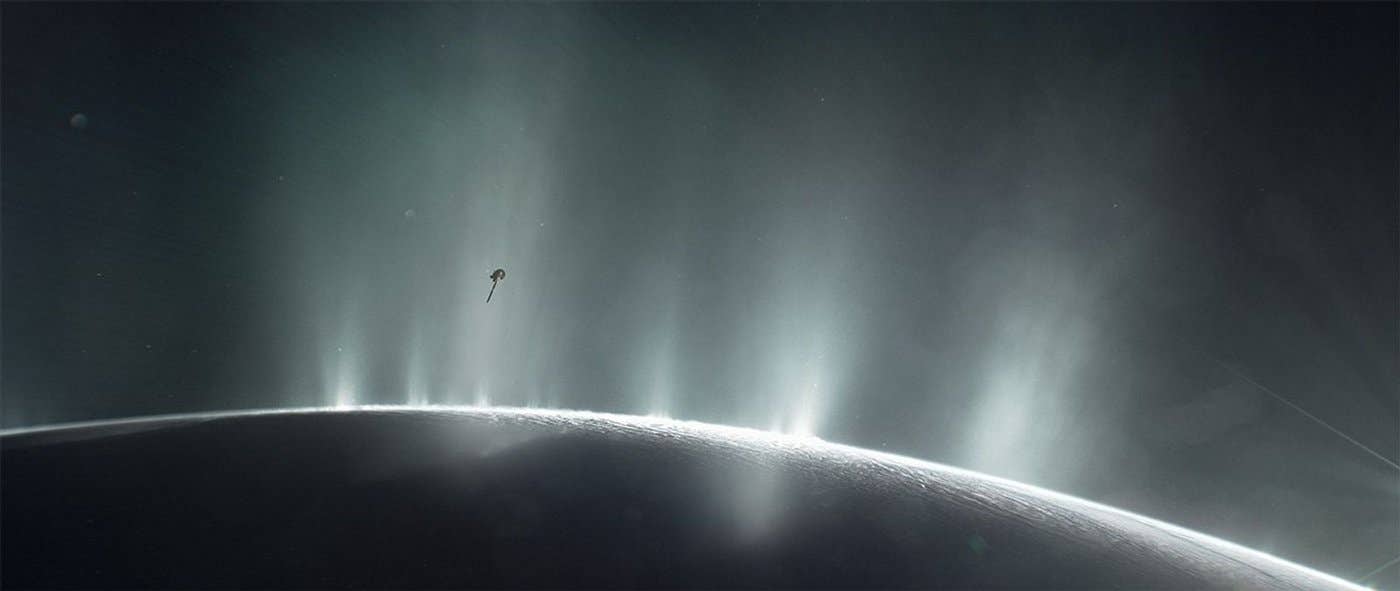Supercomputers unlock secrets of Enceladus’ icy plumes and hidden ocean
Supercomputer models reveal how Enceladus’ plumes work, reshaping mission plans to explore the moon’s hidden ocean.

Saturn’s icy moon Enceladus loses ice mass to space by cryovolcanic geyers, and new TACC supercomputer simulations have improved estimates of ice mass loss. (CREDIT: UT Austin)
It was in the 17th century that Christiaan Huygens and Giovanni Cassini first revealed Saturn's stunning rings, changing the way people understood the distant planet. Hundreds of years later, NASA's Cassini mission made a return trip to the Saturn system and came back with even more astounding results. Among them was the finding that one of Saturn's smaller moons, Enceladus, was far from dormant.
This tiny world, just 313 miles across, shoots enormous plumes of water vapor and ice into space through cracks in its south pole. Those fountains, known as "tiger stripes," create a thin atmosphere around the moon and supply Saturn's faint E ring. More importantly, they provide a direct connection to an ocean beneath Enceladus' ice shell—an environment that could, in theory, support life.
Now scientists are using cutting-edge computer simulations to find out more about how these plumes work, how much material makes it out into space, and what this can tell us about the world beneath the ice.
Simulating the Plumes
The new research was led by Aurélien Mahieux of the Royal Belgian Institute for Space Aeronomy and the University of Texas at Austin. His team turned to a technique called Direct Simulation Monte Carlo (DSMC), which tracks what becomes of billions of virtual particles as they travel and collide with one another on their path upward from the vents into the vacuum of space.
"DSMC simulations are very expensive," Mahieux explained. "We used TACC supercomputers in 2015 to obtain parameterizations to reduce computation time from 48 hours at the time to a few milliseconds now."
The Texas Advanced Computing Center (TACC) provided its Lonestar6 and Stampede3 supercomputers for the researchers to simulate the plumes from the surface up to 10 kilometers in height. That's where the gas disperses and begins to blend in with Saturn's E ring.
What the Models Reveal
At about 10 kilometers over Enceladus, the plume is still fairly dense. By replicating conditions at that height, the team created "radial profiles" that describe how temperature, velocity, and density change with distance from the vent. The profiles are readily adaptable, enabling scientists to predict how plumes will act under various vent circumstances.
The results showed how sensitively the plumes depend on such parameters as vent width and temperature. Wider vents produce wider plumes, and hotter vents eject gas more rapidly. Even small changes in these parameters have a dramatic effect on the density and shape of the jets.
At higher altitudes, collisions between molecules become rare. Here, the plume forms a cone shape, becoming more tenuous as it gets dispersed into space. The models matched well with features Cassini observed during its many flybys, such as the particle density distributions, giving scientists confidence in their approach.
Reverse Engineering the Vents
One of the most robust parts of the research was a "sensitivity analysis." The south pole of Enceladus has 98 active geyser sources with slightly different sizes and output. The simulations showed that certain properties, like vent width and mass flow rate, have a particularly strong influence in regulating the plumes.
That means spacecraft measurements of plume density or velocity can be used to work backward and infer what’s happening at the vents themselves. This “inverse modeling” links Cassini’s observations to the underground processes driving the eruptions. Mahieux’s team even narrowed down likely vent temperatures and flow rates, ruling out ranges that didn’t match Cassini’s readings.
"Our main finding in this new research is that for 100 cryovolcanic sources, we could constrain the mass flow rates and additional parameters that were not deduced before, such as the temperature at which the material was being ejected," Mahieux said. "It's a big step forward in understanding what's happening at Enceladus."
Surprisingly, the team found that Enceladus loses 20 to 40 percent less material to space than had been previously calculated in research. These new calculations sharpen estimates of the moon's ocean interacting with the surface and how long this activity might be sustained.
Building Tools for the Next Missions
One of the primary advantages of using Mahieux's work is that the models are not theoretical alone—they can be turned into rapid, functional tools for mission planning. Rather than needing to conduct long, resource-draining simulations, scientists can now generate predictions in a few seconds.
This is especially important for future missions that will try to sample the plumes or even land on Enceladus. Knowing the expected density and velocity of particles, engineers can develop instruments that won't be overwhelmed and plan safe spacecraft trajectories.
Co-author David Goldstein at UT Austin created the DSMC code called Planet in 2011. His earlier work made these advances possible. Thanks to TACC's high-performance computers, the simulations can now handle realistic pressure and much larger areas than could be done on desktop computers.
A Window Into Hidden Oceans
The interest in Enceladus is owed to more than its spectacular geysers. Scientists are convinced that beneath its icy crust lies an ocean of liquid water globally. The plumes offer a distinct chance to explore that ocean without needing to drill through miles of ice.
"There is an ocean of liquid water under these 'big balls of ice,'" Mahieux said, referring not only to Enceladus but also to Jupiter, Uranus, and Neptune moons. "The plumes at Enceladus are a window to the conditions below."
Future NASA or European Space Agency missions could use these models to determine where and how to sample the plumes for organic molecules, salts, or other signs of habitability. Some concepts take it even further, proposing landers that one day could explore the ocean itself.
"Supercomputers can give us answers to questions that we could not even dream of asking 10 or 15 years ago," Mahieux said. "We can now come much closer to simulating what nature is doing."
Practical Implications of the Research
This research goes beyond satisfying curiosity about a distant moon. The new simulations give scientists a roadmap for studying hidden oceans in icy moons across the solar system.
By knowing how plume material disperses and expands, spacecraft designers can craft superior ships, safer flybys, and more effective sampling instruments. These enhancements could increase the likelihood of detecting chemical evidence of extraterrestrial life.
For humans, the find is a reminder that Earth may not be the only world with conditions to support life. The icy moons of gas giants are maybe the holders of one of science's biggest questions: Are we alone?
Research findings are available online in the Journal of Geophysical Research Planets.
Related Stories
- New research finds water on icy moons defies the laws of physics
- Dwarf-planet Ceres’ ancient ocean may have once supported life
- Key building block for life found at Saturn’s moon Enceladus
Like these kind of feel good stories? Get The Brighter Side of News' newsletter.
Joshua Shavit
Science & Technology Writer and Editor
Joshua Shavit is a Los Angeles-based science and technology writer with a passion for exploring the breakthroughs shaping the future. As a co-founder of The Brighter Side of News, he focuses on positive and transformative advancements in AI, technology, physics, engineering, robotics and space science. Joshua is currently working towards a Bachelor of Science in Business and Industrial Engineering at the University of California, Berkeley. He combines his academic background with a talent for storytelling, making complex scientific discoveries engaging and accessible. His work highlights the innovators behind the ideas, bringing readers closer to the people driving progress.



